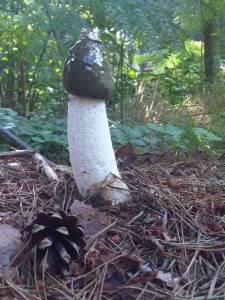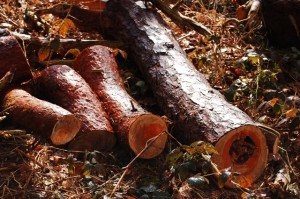Shaggy ink-cap, stinkhorns, parasols – you have to be a country person to know these are names of fungi that appear in the autumn. The parasol is a common species that likes well-drained soil and gets its name from the shape of a “lady’s parasol”. Stinkhorns have a spore mass that smell of carrion or dung in order to attract flies and insects who disperse their spores. The Shaggy ink-cap was originally boiled with cloves to make ink. From the names of fungi and mushrooms, I think our forebears had a closer relationship to wild mushrooms than our generation who view such “growths” with suspicion.
The landscape at Broxtead is a mixture of farm land, heathland, and mixed woodlands. Many of England’s finest trees grow here, particularly the English Oak (Quercus robur) so it is with great sadness we have learnt of a new disease in our Oaks called acute oak decline (A.O.D.) which kills the trees within four to five years. It is a bacterial infection causing extensive “bleeding” of a dark, sticky substance from splits in the bark. Canopy dieback is not severe until the tree is near death and as it appears to be easily transferable, it has the potential to have a serious impact on the health of our Oak trees.
We have also found a wood-boring beetle in affected trees known as the Oak Jewel beetle (Agrilus biguttatus). Since the 1990’s, this beetle is becoming increasingly common taking advantage of the tree’s weakened state and further debilitating it. The larvae feed on the inner bark, pupate to form the adult beetles which leave the tree via “D”-shaped exit holes. The Forestry Commission and the Woodland Trust are carrying out further tests. If you would like to add to their research, visit their website at www.forestresearch.gov.uk/oakdecline or contact them on sandra.denman@forestry.gsi.gov.uk.
Our onion harvest has finished now with massive yields recorded and whilst the weather continues fine and dry, we are drilling winter cereals.
With winter around the corner, the estate is cutting and delivering firewood, and muck-spreading is under way to prepare the soil for next year’s crops. Other pre-winter jobs include repairs to farm buildings and machinery maintenance of items to be laid-up for the winter.
Whilst we enjoy the current sunny days and mild temperatures, gardens and fields are bouncing with Greenfinches, Gold finches, Blue-tits and Great-tits who love to feed on seed heads, in particular, thistles. Grey squirrels scurry everywhere hiding their winter-store of nuts. A particularly laden walnut tree outside the office has been systematically raided over the last few weeks by these clever little tree-rats.





